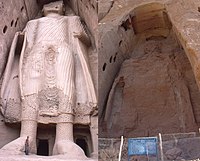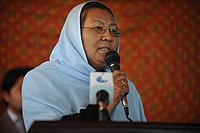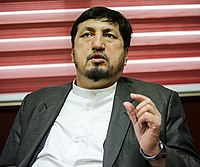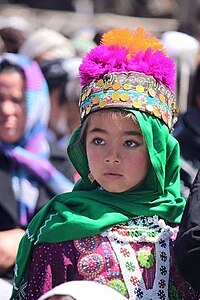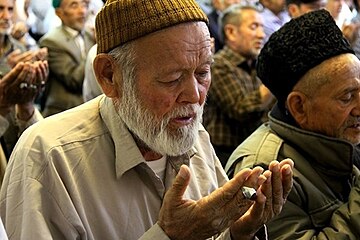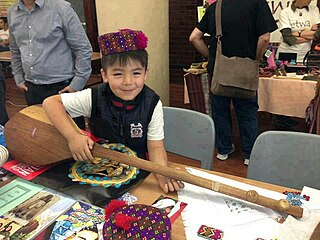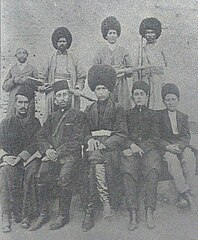Hazaras
This article has multiple issues. Please help improve it or discuss these issues on the talk page. (Learn how and when to remove these template messages)
|
| [17][18][19][20][21][22] |
The Hazaras (
Hazaras are one of the most persecuted groups in Afghanistan.
Etymology
The etymology of the word "Hazara" remains disputed, but some have differing opinions on the term.
- It is said that the name "Hazara" (Hazāra هزاره) derives from the Persian word "Hazar" (Hazār هزار) meaning "thousand". It may be the translation of the
- Historian Abdul Hai Habibi considers the word "Hazara" (Hazāra هزاره) to be very old, and it is derived from "Hazala" (həzālə هزاله), which has changed to "Hazara" over time and has meant "good-hearted".[31][32]
- Some believe that in ancient times, because of the Hazara people's high population, they were called "Hazara" (Hazāra هزاره), which the name "Hazara" derives from the thousand" and it is a metaphor for a population of over thousand.[33]
- The Hazaras are mentioned in the Baburnama. This work mentions such groups of Hazaras as Sultan Masaudi Hazaras[34] and Turkoman Hazaras.[35][36] The commentary to the main text also mentions another group under the name Kedi Hazaras.[34]
Origin

Despite being one of the principal population elements of Afghanistan,
Over the course of centuries, invading
Despite being a mix of multiple distinct ethnicities, a number of researchers in their works write focusing on the Mongolic component. Authors, along with the term Hazaras, use the name Hazara Mongols: such as Elizabeth Emaline Bacon,[15][43] Barbara A. West,[44] Yuri Averyanov,[45] Elbrus Sattsayev[46] and other. According to historian Lutfi Temirkhanov, the Mongolian detachments left in Afghanistan by Genghis Khan or his successors became the starting layer, the basis of the Hazara ethnogenesis.[14] According to him, the Turkic elements compared to the Mongolian ones played a secondary role.[47] The Hazaras in the Ghilji neighborhood are called Mongols.[48] The participation of the Mongols in the ethnogenesis of the Hazaras is evidenced by linguistic data, historical sources, data on toponymy,[49] as well as works on population genetics.[50] Such scholars as Vasily Bartold,[51] Ármin Vámbéry,[52] Vadim Masson, Vadim Romodin,[53] Ilya Petrushevsky,[54] Allah Rakha, Fatima, Min-Sheng Peng, Atif Adan, Rui Bi, Memona Yasmin, Yong-Gang Yao wrote about the historical use of the Mongolian language by the Hazaras.[55]
Genetics
Genetically, the Hazara combine varying amounts of
The frequency of ancestry components among the Hazaras vary according to tribal affiliation. They display high genetic affinity to present-day Turkic populations of Central Asia and Mongolic populations of East Asia.[58] In terms of their overall genetic makeup, around 49% of the Hazaras average gene pool is derived from East Asian-like sources, around 48% is derived from European-like sources, and around 0,17%, 0,47%, and 2,30% is derived from African, Oceanian, and Amerindian-like sources respectively.[59]
One analysis argues that the Hazaras are closely related to the Turkic populations of Central Asia, rather than
Other study demonstrate that Hazara shares more alleles with East Asians than with other Central Asians and carries 57.8% Mongolian-related ancestry.[58][62] Hazaras have experienced genetic admixture with the local or neighboring populations and formed the current East-West Eurasian admixed genetic profile after their separation from the Mongolians.[58]
Paternal haplogroups
The most common paternal DNA haplogroups of Hazaras from Afghanistan are the East Eurasian C-M217 (33,33%) and West Eurasian R1a1a-M17 (6.67%) clades, followed by West Eurasian J2-M172 and L-M20. Some Hazaras were also found to belong to the haplogroup E1b1b1-M35, L-M20 and H-M69, which are shared with
C2 (previously known as C3-Star cluster) was the most frequent haplogroup in Pakistani and Afghan Hazaras.
Maternal haplogroups
The Hazara share c. 35% maternal haplogroups with contemporary East Asian populations, while c. 65% is shared with West Eurasian populations.[68] The Hazaras as a whole have mostly West Eurasian mtDNA.[69][70][71]
History
The first mention of Hazaras is made by
19th century
During the second reign of Dost Mohammad Khan in the 19th century, Hazaras from Hazarajat began to be taxed for the first time. However, for the most part, they still managed to keep their regional autonomy until the 1892 Battle of Uruzgan[75] and subsequent subjugation of Abdur Rahman Khan began in the late 19th century.[76]
When the
These campaigns had a catastrophic impact on the demographics of Hazaras causing over sixty percent of the total Hazara population to be
After these massacres, Abdul Rahman Khan forced many Hazara families from the Hazara areas of
20th and 21st century
This section's tone or style may not reflect the encyclopedic tone used on Wikipedia. (October 2018) |

In 1901,
Mistrust of the central government by the Hazaras and local uprisings continued. In particular, from 1945 to 1946, during
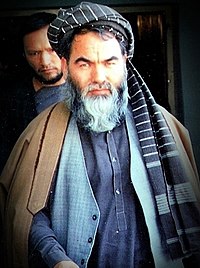
The repressive policies[clarification needed] of the People's Democratic Party of Afghanistan (PDPA) after the Saur Revolution in 1978 caused uprisings throughout the country. Fearing Iranian influence, the Hazaras were particularly persecuted. President Hafizullah Amin published in October 1979 a list of 12,000 victims of the Taraki government. Among them were 7,000 Hazaras who were shot in the notorious Pul-e-Charkhi prison.[82]
During the
In 1997, a revolt broke out among Hazaras in Mazar-e Sharif when they refused to be disarmed by the Taliban; 600 Taliban were killed in subsequent fighting.[84] In retaliation, the genocidal policies of Abdur Rahman Khan's era was adopted by the Taliban. In 1998, six thousand Hazaras were killed in the north; the intention was ethnic cleansing of Hazaras.[85] In March 2001, the two giant Buddhas of Bamiyan, were also destroyed even though there was a lot of condemnation.[86]

Hazaras have also played a significant role in the creation of Pakistan. One such Hazara was Qazi Muhammad Isa of the Sheikh Ali tribe, who had been close friends with Muhammad Ali Jinnah, having met each other for the first time while they were studying in London. He had been the first from his native province of Balochistan to obtain a Bar-at-Law degree and had helped set up the All-India Muslim League in Balochistan.[87][88]
Though Hazaras played a role in the anti-Soviet movement, other Hazaras participated in the new communist government, which actively courted Afghan minorities.
During the years that followed, Hazara suffered severe oppression, and many ethnic massacres, genocides, and pogroms were carried out by the predominantly ethnic Pashtun Taliban and are documented by such groups as the Human Rights Watch.[91]
Following the
Although Afghanistan has been historically one of the poorest countries in the world, the Hazarajat region has been kept less developed by past governments. Since the ousting of the Taliban in late 2001, billions of dollars poured into Afghanistan for reconstruction and several large-scale reconstruction projects took place in Afghanistan from August 2012. For example, there have been more than 5000 kilometers of road pavement completed across Afghanistan, of which little was done in central Afghanistan (Hazarajat). On the other hand, the
Discrimination indicates that
The drive by President Hamid Karzai after the Peace Jirga to strike a deal with Taliban leaders caused deep unease in Afghanistan's minority communities, who fought the Taliban the longest and suffered the most during their rule. The leaders of the Tajik, Uzbek and Hazara communities, vowed to resist any return of the Taliban to power, referring to the large-scale massacres of Hazara civilians during the Taliban period.[98]
Following the fall of Kabul to the Taliban in 2021, which ended the war in Afghanistan, concerns were raised as to whether the Taliban would reimpose the persecution of Hazaras as in the 1990s. An academic at Melbourne's La Trobe University said that "The Hazaras are very fearful that the Taliban will likely be reinstating the policies of the 1990s" despite Taliban reassurances that they will not revert to the bad old ways of the 1990s.[99][100]
-
Mohammed Fahim, George W. Bush, facing Hamid Karzai.
-
Bamyan provincein Afghanistan.
-
Afghanistan Parliament.
-
Kabul province from 2005 to 2010. He is the former Afghanistan's ambassador to Sweden.
Demographics
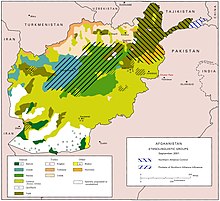
Some sources claim that Hazaras comprise about 20 to 30 percent of the total
Geographic distribution
Afghanistan
This section needs expansion. You can help by adding to it. (October 2023) |

The Hazaras are one of the largest
Until the 1880s, the Hazaras were completely autonomous and controlled the entire Hazaristan region. Nowadays, the vast majority of Hazaras reside in Hazaristan and many others reside in the cities of the country.[citation needed]
Central Asia
After the massacre and genocide of the Hazaras by Abdur Rahman in 1888–1893, many Hazaras migrated to Central Asia regions under the occupation of Tsarist Russia, such as Uzbekistan, Tajikistan, Turkmenistan, and Kazakhstan, and some of them settled mostly in Samarkand and Bukhara. Over time, a large number of Hazaras living in the regions of Tsarist Russia lost their accent, language and ethnic identity due to the similarities of their racial structure and appearance with the people of those regions and were assimilated among them.[80][103]
Pakistan
During the period of
Most Pakistani Hazaras are native to
Despite all of this, Hazaras are often targeted by militant groups such as the
Iran

The Hazara people in
India
This section needs expansion. You can help by adding to it. (October 2023) |
The
Diaspora
Culture and society
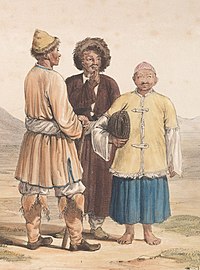
Hazara culture is a combination of customs, traditions, behaviors, beliefs, and norms that have been formed in interaction and confrontation with the surrounding phenomena for many years and now it is displayed as a cultural identity. The Hazara culture is rich in heritage, with many unique cultures, and has common influences with various cultures of
Attire
Hazara clothing have an important and special role in supporting the cultural, traditional and social identity of the Hazara ethnicity. Hazara clothes are produced manually and by machine; In Afghanistan these types of clothes are sewn in most parts of the country, especially in central provinces of Afghanistan.[120][121]
Male clothing
Hazara men traditionally wear
Female clothing
The traditional clothing of Hazara women includes a pleated skirt with a
Headgear
Hazaras traditionally wear headgear or hats, which are of different types for men and women. There are different types of Hazara hats and caps, some of which are made from animal skin and some from barak. Also some Hazara men wear the
Cuisine
The Hazara cuisine is strongly influenced by
Language
The Hazaras speak the
According to
According to Doctor of Sciences Lutfi Temirkhanov, the ancestors of the Hazaras were Mongol-speaking[14][49] and only after the resettlement, they mixed with the Persian-speaking and Turkic-speaking population: "hordes of Mongol princes and feudal lords found themselves in a Persian-speaking encirclement; they mixed with them, were influenced by the Persian-Tajik culture and gradually adopted the Persian language".[131] According to a number of sources, in the 16th century the Mongolian language was common among the Hazaras.[53][51] According to Encyclopaedia Iranica, during the life of Babur part of their population spoke a Mongolian language.[24] According to the Great Russian Encyclopedia, until the 19th century Hazaras spoke Mongolian.[16][52][54][55] And according to Temirkhanov, the Mongolian elements make up 10% of the Hazara vocabulary.[132] The Turkic and Mongolic words make up about 20% of the vocabulary of Hazaragi dialect.[133]
Religion
Hazaras predominantly practice
Shia Hazaras
This section needs expansion. You can help by adding to it. (September 2023) |
There is no single theory about the acceptance of the Shi'a Islam by the majority of Hazaras. Probably most of them accepted Shi'a Islam during the first part of the 16th century, in the early days of the Safavid dynasty.[134][12][13]
Sunni Hazaras
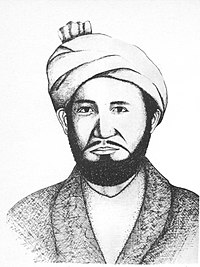
A significant and almost a large population of Hazara people are Sunni Muslims. Sunni Hazaras have been Sunni since long ago and before the occupation of
A Sunni Hazara, Sher Muhammad Khan Hazara, the
Isma'ili Hazaras
Hazara tribes
The Hazara people have been organized by various
Art


Writers and poets
Some well-known Hazara writers and poets include
Music
Many Hazara musicians are widely hailed as being skilled in playing the
Renowned
Cinema
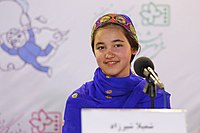
Hazara cinema artists have no older background, but nowadays some of their famous actors and actresses include Hussain Sadiqi, Abid Ali Nazish, Shamila Shirzad, Nikbakht Noruz, and others.
Sports


Many Hazaras engaged in varieties of sports, including
Rohullah Nikpai, won a bronze medal in Taekwondo at the Beijing Olympics 2008, beating world champion Juan Antonio Ramos of Spain 4–1 in a play-off final. It was Afghanistan's first-ever Olympic medal. He then won a second Olympic medal for Afghanistan in the London 2012 games.[citation needed]
Another notable Hazara athlete Sayed Abdul Jalil Waiz was the first ever
Hazara football players are
Some Hazara from Pakistan have also excelled in sports and have received numerous awards, particularly in boxing, football and field hockey.
Pakistani Hazara Abrar Hussain, a former Olympic boxer served as deputy director-general of the Pakistan Sports Board. He represented Pakistan three times at the Olympics and won a gold medal at the 1990 Asian Games in Beijing. Another Hazara boxer from Pakistan is Haider Ali a Commonwealth Games gold medalist and Olympian who is currently retired.
Former captain of the
Another is Kulsoom Hazara, a Pakistani female karate champion who has won several gold, silver and bronze medals on national and international stages, including Pride of Pakistan Award.[149] Other karateka Hazaras include Nargis Hameedullah who became the first Pakistani woman to win an individual medal (a bronze) at the Asian Games karate championship, and Shahida Abbasi.[citation needed]
Cultural sports
Cultural sports of Hazara people are those sports that have been inherited from their ancestors for generations.
Buzkashi

Buzkashi is a Central Asian sport in which horse-mounted players attempt to place a goat or calf carcass in a goal. It is the national sport in Afghanistan and is one of the cultural sports of the Hazara people and they still practice this sport in Afghanistan.[150]
Tirandāzi
Tirandāzi is a kind of archery and an old cultural sport of Hazaras.[151]
Pahlawani
Notable people
Gallery
- Flags
- Pictures
-
Hazara men in the uniform of theNational Army of Afghanistan
-
Hazara young men in Kabul
-
An elderly Hazara man
-
Ghazni province
-
Hazara men on the anniversary of the death of Abdul Ali Mazari in Kabul
-
Hazara schoolboys
- Cultural
-
Hazara girls from Ghazni province
-
Hazara boy in cultural clothing with a dambura
- Historical
-
An 1879 portrait of a Daizangi Hazara man
See also
| Part of a series on |
| Hazaras |
|---|
 |
|
|
|
References
- ^ "سرور دانش درصد جمعیت شیعه و هزاره را در گزارش دولت آمریکا نادرست خواند". BBC News فارسی (in Persian). Retrieved 2023-01-08.
- ^ Garrison, V. David. "Global Peoples Profiles:: Hazara of Afghanistan and Deccanis of India". www.missionfrontiers.org. Retrieved 2024-01-08.
- ^ Siddique, Abubakar (21 February 2013). "Hazaras of Pakistan". Radio Free Europe/Radio Liberty. Retrieved 22 Dec 2022.
- ^ Census of Afghans in Pakistan 2005, UNHCR Statistical Summary Report (retrieved August 14, 2016)
- ^ Yusuf, Imran (5 October 2011). "Who are the Hazara?". Tribune. Retrieved 1 September 2016.
- ^ a b Smyth, Phillip (3 June 2014). "Iran's Afghan Shiite Fighters in Syria". The Washington Institute for Near East Policy. Retrieved 22 June 2017.
- ^ "Austria holds refugee talks as young Hazaras flee persecution to make 'dangerous' journey to Europe – ABC News (Australian Broadcasting Corporation)". mobile.abc.net.au. 2016-02-29. Retrieved 2017-08-19.
- ^ "Cultural Diversity". Australian Bureau of Statistics. 2021-08-10. Retrieved 2022-06-28.
- ^ "Afghan Hazara Refugees Seek Justice in Turkey". 3 June 2014.
- ^ a b The population of people with descent from Afghanistan in Canada is 48,090. Hazara make up an estimated 30% of the population of Afghanistan depending to the source. The Hazara population in Canada is estimated from these two figures. Ethnic origins, 2006 counts, for Canada Archived 2018-12-24 at the Wayback Machine
- ^ Afghan Hazaras' new life in Indonesia: Asylum-seeker community in West Java is large enough to easily man an eight-team Afghan football league, Al Jazeera, 21 March 2014, retrieved 5 August 2016
- ^ a b c The Afghans, Their History and Culture, Religion Archived 2010-12-28 at the Wayback Machine
- ^ a b c "شناسنامه الکترونیکی،آخرین فرصت تثبیت هویت هزارههای سنی و اسماعیلی | سایت طرح نو، باشگاه اندیشه و گفتوگو". Retrieved 2021-02-02.
- ^ a b c d Temirkhanov L. (1968). "О некоторых спорных вопросах этнической истории хазарейского народа". Советская этнография. 1. P. 86. In Russian: "...монгольские отряды, оставленные в Афганистане Чингиз-ханом или его преемниками, стали исходным пластом, основой хазарейского этногенеза. "
- ^ a b c Bacon, Elizabeth Emaline (1951). The Hazara Mongols of Afghanistan: A Study in Social Organization. Berkeley: University of California.
- ^ a b c "Хазарейцы • Большая российская энциклопедия - электронная версия". bigenc.ru. In Russian: "Упоминаются с 16 в. До 19 в. говорили на монг. языке."
- JSTOR 23345249.
- ^ B. Campbell, Disappearing people? Indigenous groups and ethnic minorities in South and Central Asia in: Barbara Brower, Barbara Rose Johnston (Ed.) International Mountain Society, California, 2007.
- ^ "Sunni Hazaras of Afghanistan". September 17, 2020.
- ^ ISBN 978-9936-624-00-9.
- ^ a b Babur, (Emperor of Hindustan) (1826). Memoirs of Zehir-Ed-Din Muhammed Baber: Emperor of Hindustan. Longman, Rees, Orme, Brown, and Green.
- ^ PMID 20823912.
- .
Hazaras are one of the oppressed and dispossessed national minority communities of the country.
- ^ a b Alessandro Monsutti (15 December 2003). "HAZĀRA ii. HISTORY". Encyclopædia Iranica. Retrieved 16 December 2012.
- ISBN 978-1-136-80016-0.
- ^ Schurmann, H. F. (1962). The Mon-gols of Afghanistan: An Ethnography of the Moghôls and Related Peoples of Afghanistan. La Haye. p. 115.
- The Hazâras. Stockton. p. 22.
- Mousavi, Sayed Askar (1998). The Hazaras of Afghanistan[An Historical, Cultural, Economic and Political Study]. Richmond. pp. 23–25.
- ^ a b c Khazeni, Arash; Monsutti, Alessandro; Kieffer, Charles M. (December 15, 2003). "HAZĀRA". Encyclopædia Iranica. Retrieved December 23, 2007.
- ISBN 978-9936-624-00-9.
- ^ یزدانی، حسینعلی. پژوهشی در تاریخ هزارهها. چاپخانه مهتاب. ص 96
- ^ "هزاله – لغتنامهٔ دهخدا" [Dehkhoda Dictionary]. abadis.ir. Retrieved 2022-01-07.
- ^ "هزاره".
- ^ a b c Zahīr ud-Dīn Muhammad Babur (1921)."Memoirs Of Zehir-Ed-Din Muhammed Babur. Volume 1.". Oxford University Press. Pages 44, 243, 279."
- ^ Babur, Z. M. (1987). Babur-nama. Lahore. pp. 300, 207, 214, 218, 221, 251–53.
{{cite book}}: CS1 maint: location missing publisher (link) - ^ Babur, Zahīr ud-Dīn Muhammad (1826). Memoirs of Zehir-Ed-Din Muhammed Baber: Emperor of Hindustan. Longman, Rees, Orme, Brown, and Green.
- ^ a b c Monsutti, Alessandro (2017-07-01), "Hazāras", Encyclopaedia of Islam, THREE, Brill, retrieved 2022-05-07
- ^ a b c Bosworth, C. E. (2012-04-24), "Hazāras", Encyclopaedia of Islam, Second Edition, Brill, retrieved 2022-05-08
- ^ "HAZĀRA ii. HISTORY – Encyclopaedia Iranica". Iranicaonline.org. Retrieved 2021-03-12.
- ISBN 978-0-7637-5868-4.
- ISBN 978-9936-624-00-9.
- ^ B. Campbell, Disappearing people? Indigenous groups and ethnic minorities in South and Central Asia in Barbara Brower, Barbara Rose Johnston (Ed.) International Mountain Society, California, 2007
- ^ Elizabeth E. Bacon. (1951). "The Inquiry into the History of the Hazara Mongols of Afghanistan". Southwestern Journal of Anthropology. Vol. 7. No. 3. pp. 230–247.
- ISBN 978-1-4381-1913-7.
- ^ Аверьянов Ю. А. (2017). "Хазарейцы - ираноязычные монголы Афганистана"". Мир Центральной Азии. pp. 110–117.
- ^ Сатцаев Э. Б. (2009). "Монголы-хазарейцы Афганистана и аспекты "народного шиизма"". Единая Калмыкия в единой России: через века в будущее. pp. 413–415.
- ^ Temirkhanov L. (1968). "О некоторых спорных вопросах этнической истории хазарейского народа". Советская этнография. 1. P. 94. In Russian: "тюркские элементы ... по сравнению с монгольскими ... играли второстепенную роль."
- ^ Temirkhanov L. (1968). "О некоторых спорных вопросах этнической истории хазарейского народа". Советская этнография. 1. P. 91. In Russian: "Ближайшие соседи хазарейцев – гильзаи – называли и называют их «монголы»."
- ^ a b Temirkhanov L. (1968). "О некоторых спорных вопросах этнической истории хазарейского народа". Советская этнография. 1. P. 91. In Russian: "Об участии монголов в этногенезе хазарейцев свидетельствуют и данные лингвистики... также исторические источники (например, «Записки Бабура») и данные топонимики"
- ^ Sabitov Zh. M. (2011)."Происхождение хазарейцев с точки зрения ДНК-генеалогии". The Russian Journal of Genetic Genealogy. 2 (1): pp. 37–40.
- ^ a b Бартольд. В. В. (2022). Ислам. Культура мусульманства. Москва: Litres. p. 162. In Russian: "...еще в XVI веке говорили хазарейцы по-монгольски в северной части Афганистана..."
- ^ a b Ármin Vámbéry (2003). Путешествие по Средней Азии. Москва: Восточная литература. In Russian: "Говорят, что хазарейцы ... были перевезены Чингисханом из Монголии, своей прародины, на юг Средней Азии и благодаря влиянию шаха Аббаса II обращены в шиизм. Поразительно, что они заменили свой родной язык персидским, который даже в населенных ими областях не повсеместно распространен, и лишь небольшая часть, оставшаяся изолированной в горах поблизости от Герата и уже несколько столетий занимающаяся выжиганием угля, говорит на некоем жаргоне монгольского языка."
- ^ a b Массон В. М., Ромодин В. А. (1964). История Афганистана. Том I. С древнейших времен до начала XVI века. Москва: Наука. pp. 289–290. In Russian: "Еще в XVI в., по сообщению Бабура, среди хазарейцев был распространен монгольский язык, а небольшая часть их, по-видимому, и в XIX в. говорила на языке, близком к монгольскому."
- ^ a b Петрушевский И. П. (1952). Рашид-ад-дин и его исторический труд. Москва/Ленинград: Издательство Академии Наук СССР. P. 29. In Russian: "Как известно, большой массив монгольского населения (хезарейцы), отчасти сохранявшего свой язык еще в XIX в., сложился на территории Афганистана..."
- ^ a b Allah Rakha, Fatima, Min-Sheng Peng, Atif Adan, Rui Bi, Memona Yasmin, Yong-Gang Yao (2017)."mtDNA sequence diversity of Hazara ethnic group from Pakistan". Forensic Science International: Genetics. Volume 30: Pages e1-e5. In English: "Moreover, there are also lines of evidence that some of the remote tribes of Hazaras spoke Mongol language till last century. Their central Asian facial features including sparse beards, high cheekbones and epicanthic eye folds further supports their Mongol origin."
- ^ PMID 22470552.
- S2CID 8127224.
- ^ S2CID 195761020.
The results from pairwise genetic distances, MDS, PCA, and phylogenetic relationship reconstruction demonstrate that present-day Hazaras are genetically closer to the Turkic-speaking populations (Uyghur, Kazakh, and Kyrgyz) residing in northwest China than with other Central/South Asian populations and Mongolian. Outgroup and admixture f3, f4, f4-ratio, qpWave, and qpAdm results further demonstrate that Hazara shares more alleles with East Asians than with other Central Asians and carries 57.8% Mongolian-related ancestry. Overall, our findings suggest that Hazaras have experienced genetic admixture with the local or neighboring populations and formed the current East-West Eurasian admixed genetic profile.
- ^ S2CID 203569169.
Historical and genetic evidence suggests that the Hazara derived a large degree oftheir ancestry from Mongolians during the Mongolian expansion in the Genghis Khan period... Overall, we genotyped 25 forensic-related markers in 261 Quetta Hazara individuals and provided the first batch of 23-autosomal STRs for forensic genetics and population genetics research. 23-autosomal STRs included in Huaxia Platinum were polymorphic in the Hazara population and could be used as powerful tool for forensic investigations. Population genetic comparisons based on two datasets via PCA, MDS and phylogenetic relationship reconstruction consistently indicated that the Quetta Hazara in Pakistan shared significant genetic components with Central Asians, especially for Turkic-speaking populations.
- PMID 20823912.
Our study confirms the results of Li et al's study that cluster the Hazara population with Central Asian populations, rather than Mongolian populations, which is consistent with ethnological studies. Our results further extend these findings, as we show that the Hazaras are closer to Turkic-speaking populations from Central Asia than to East-Asian or Indo-Iranian populations.
- PMID 28595347.
- ^ .
- PMID 22470552.
- ^ John William Whale. Mitochondrial DNA Analysis of Four Ethnic Groups of Afghanistan. http://eprints.port.ac.uk/9862/1/John_Whale_MPhil_Thesis_2012.pdf Archived 2017-08-02 at the Wayback Machine
- PMID 27627454. "Eastern Russian Tatars, Bashkirs, and Pakistani Hazara were found to carry R1b-M343 at unusually high frequencies of 12.65%, 46.07%, and 32%, respectively, compared to other regions of Eastern Asia, which rarely have this haplotype"
- ^ Sabitov Zh. M. (2011)."Происхождение хазарейцев с точки зрения ДНК-генеалогии". The Russian Journal of Genetic Genealogy. 2 (1): pp. 37–40. In Russian: "Гаплогруппа СЗ безусловно связана с экспансией монголов..."
- ^ Жабагин М. К. (2017). Анализ связи полиморфизма Y-хромосомы и родоплеменной структуры в казахской популяции Москва. p. 71. In Russian: "...за счет высокой частоты гаплогруппы С2-М217, что согласуется с монгольским происхождением хазарейцев."
- ^ Allah Rakha, Fatima, Min-Sheng Peng, Atif Adan, Rui Bi, Memona Yasmin, Yong-Gang Yao (2017)."mtDNA sequence diversity of Hazara ethnic group from Pakistan". Forensic Science International: Genetics. Volume 30: Page 3.
- PMID 15077202.
- ^ "MtDNA sequence diversity of Hazara ethnic group from Pakistan". Retrieved 2021-03-12.
- PMID 15077202.
- ^ a b c d e "HAZĀRA: ii. HISTORY". Alessandro Monsutti (Online ed.). United States: Encyclopædia Iranica. December 15, 2003. Retrieved 9 August 2012.
- Fletcher School of Law and Diplomacy. Archived from the originalon 2011-09-18. Retrieved 2011-11-02.
- ^ "Ahmad Shah and the Durrani Empire". Library of Congress Country Studies on Afghanistan. 1997. Retrieved 2010-08-25.
- ISSN 0362-4331. Retrieved 2022-08-21.
- OCLC 1100424512.
- ^ ISBN 978-9936-8015-0-9.
- ^ کاتب, فیضمحمد (1913). سراجالتواریخ. کابل: مطبعه دارالسلطنته.
- ^ Zamani, Ezzatullah (September 2019). "The 'Genocide of the Hazaras' in Afghanistan from 1884 to 1905 and subsequent genocidal campaigns and target killings against them in the 21st century". Genocide of the Hazaras of Afghanistan.
- ^ a b "کوچ اجباری و اثرات فرهنگی واجتماعی آن بر جامعه هزاره". archive.mashal.org. Retrieved 2022-08-31.
- ISBN 978-1-61069-778-1.
- ISBN 1-85065-703-3.
- ISBN 978-0-300-08902-8.
- ^ Ahmed Rashid, Taliban: Militant Islam, Oil, and Fundamentalism in Central Asia, London and New Haven, 2000, p. 58
- ^ Ahmed Rashid, Taliban: Militant Islam, Oil, and Fundamentalism in Central Asia, London and New Haven, 2000, pp. 67–74
- ^ "Taliban blow apart 2,000 years of Buddhist history". The Guardian. 3 March 2001.
- ^ "Who is Justice Qazi Faez Isa?". DAWN.COM. June 19, 2020.
- ^ "Qazi Muhammad Isa and the reference against Justice Qazi Faez Isa". June 14, 2020.
- ^ Fida Yunas, S. (2008). Pg 33. Sultan Ali Kishtmand had remained Prime Minister of Afghanistan from 10 January 1981 to 26 May 1990, with a brief break of about nine months, when Dr Hassan Sharq replaced him from 20 June 1988 to .... Retrieved 2012-07-30.
- ISBN 978-0-8122-0615-9. Retrieved 2012-07-30.
- ^ "Afghanistan: massacres of Hazaras". Human Rights Watch. February 2001. Retrieved December 27, 2007.
- ^ National Geographic. Archived from the originalon March 2, 2008. Retrieved August 9, 2012.
- ^ Sappenfield, Mark (August 6, 2007). "Afghanistan's success story: The liberated Hazara minority". Christian Science Monitor. Retrieved December 27, 2007.
- ^ "Many Karzai rivals find way to Parliament". Pajhwok.com. 2011-01-22. Archived from the original on 2012-03-13. Retrieved 2012-07-30.
- ^ "(27 February 2012) Afghanistan set to host second national ski race. wanderlust.co.uk". Wanderlust.co.uk. Archived from the original on 4 August 2017. Retrieved 30 October 2017.
- ^ Levinson, Charles (March 7, 2012). "Since Skiing Came to Afghanistan, It Has Been Pretty Much All Downhill". Wall Street Journal.
- ^ a b "Afghan nomad clashes raise fears of ethnic strife". Bangkok Post. Agence France-Presse. 7 August 2012.
- ^ "Afghan Overture to Taliban Aggravates Ethnic Tensions". The New York Times, 27 June 2010.
- ^ "Afghanistan's minority Hazaras see gains of past two decades 'falling apart'". France 24. 23 August 2021. Retrieved 31 August 2021.
- ^ Mogul, Rhea (29 August 2021). "Afghanistan's religious minorities live in fear of Taliban, brace for persecution". NBC News. Retrieved 31 August 2021.
- ^ a b "AFGHANISTAN iv. Ethnography". L. Dupree (Online ed.). United States: Encyclopædia Iranica. December 15, 1983.
- ^ Dames, M. Longworth (2012-04-24), "Hazāra", Encyclopaedia of Islam, First Edition (1913–1936), Brill, retrieved 2023-08-09
- ^ موسوی, سید عسکر. هزارههای افغانستان. pp. 204–205.
- ^ پولادی, حسن (1387). هزارهها.
- ^ "Hussain Ali Yousafi, chairman of the Hazara Democratic Party'", BBC News, 26 January 2009
- ^ a b Bigg, Matthew (2012-10-25). "Insight: Pakistani death squads spur desperate voyage to Australia". Reuters. Retrieved 8 December 2013.
- Dawn.com. Retrieved 2012-07-30.
- ^ "List of Political parties". Hazarapress.com. Retrieved 2012-07-30.
- ^ Ed (2012-04-24), "Berberi", Encyclopaedia of Islam, Second Edition, Brill, retrieved 2023-08-13
- ^ اینترنشنال, هزاره (2014-05-11). "ایل هزاره در خراسان و فرهنگ جعلی جلیل آریایی". هزاره اینترنشنال (in Persian). Retrieved 2023-08-13.
- ^ ""«شورش خراسان» در کتابفروشیها شکل میگیرد"" (PDF). Archived from the original (PDF) on 2018-05-17. Retrieved 2022-12-29.
- ISBN 978-600-6732-68-8.
- ^ ISBN 978-81-7991-104-4.
- ISBN 978-0-415-97508-7.
- ISBN 978-0-415-97508-7.
- ^ Australia ships out Afghan refugees BBC News.
- ^ a b Latham, Robert Gordon (1859). Eastern and northern Asia Europe. J. van Voorst. p. 333. Retrieved 2013-12-08.
- ^ افغانستان, روزنامه. "استقبال گسترده از روز فرهنگ هزارگی در کشور – روزنامه افغانستان". www.dailyafghanistan.com (in Persian). Retrieved 2022-09-10.
- ^ Spuler, B. (2012-04-24), "Aymak", Encyclopaedia of Islam, Second Edition, Brill, retrieved 2023-08-15
- ^ a b c tebyan.net, موسسه فرهنگی واطلاع رسانی تبیان | (2017-06-09). "لباس های سنتی زنان و مردان هزاره". fa. Retrieved 2022-08-28.
- ^ a b c "Clothing of the Hazāra Tribes". Encyclopædia Iranica. Retrieved 31 August 2022.
- Encyclopaedia Iranica. Retrieved 31 August 2022.
- ^ Foundation, Encyclopaedia Iranica. "Clothing of the Hazāra tribes". iranicaonline.org. Retrieved 2023-09-24.
- ^ tebyan.net, موسسه فرهنگی واطلاع رسانی تبیان | (2017-06-09). "لباس های سنتی زنان و مردان هزاره". fa (in Persian). Retrieved 2023-09-24.
- ^ a b "Attitudes towards Hazaragi". pp. 1–2. Retrieved June 5, 2014.
- ^ a b c Kieffer, Charles M. "HAZĀRA" [iv. Hazāragi dialect]. Encyclopædia Iranica. Retrieved August 22, 2017.
- ^ "Hazara people • Britannica" In English: "The Hazara speak an eastern variety of Persian called Hazaragi with many Mongolian and Turkic words."
- OCLC 33814814
- ^ Farhadi, A. G. Ravan (1955). Le persan parlé en Afghanistan: Grammaire du kâboli accompagnée d'un recuil de quatrains populaires de la région de Kâbol. Paris.
- ^ "Languages in Afghanistan". The Swedish Committee for Afghanistan (SCA). Retrieved 2021-02-14.
- ^ Temirkhanov L. (1968). "О некоторых спорных вопросах этнической истории хазарейского народа". Советская этнография. 1. P. 93-94. In Russian: "орды монгольских царевичей и феодалов оказались в таджикском окружении; они смешивались с таджиками, подвергались влиянию персидско-таджикской культуры и постепенно принимали язык таджиков, отсюда и таджикская речь хазарейцев".
- ^ Temirkhanov L. (1968). "О некоторых спорных вопросах этнической истории хазарейского народа". Советская этнография. 1. P. 91. In Russian: "монгольские элементы составляют 10% хазарейской лексики".
- ^ خاوری, محمد جواد. امثال و حِکم مردم هزاره. مشهد: نشر عرفان. p. 16.
- ISBN 978-1-85065-703-3. Retrieved 2012-07-30.
- ISBN 978--964-06-0527-1.
- ^ گیزابی, محمداکرم (1375). هزارهها و هزارستان اثر گروه تحقیقی پیدی میتلند. ترجمهٔ محمداکرم گیزابی. مجمع نویسندگان افغانستان. p. 192.
- ISBN 978-9936-624-00-9.
- ^ خواتی, شفق (1382). مجله طلوع. pp. 52–68.
- ^ Hazara tribal structure, Program for Culture and Conflict Studies, US Naval Postgraduate School
- ^ "The Hazara Nationalism: in Music and Historical Literature". 24 December 2014.
- ^ "قیچک – لغتنامه دهخدا [Dehkhoda Dictionary]".
- ^ Nordland, Rod; Faizi, Fatima (September 20, 2018). "'Suicider!' Came the Warning. For Afghans, Wrestlers' Deaths Resound. (Published 2018)". The New York Times. Archived from the original on 2022-01-03 – via NYTimes.com.
- from the original on 2022-01-03. Retrieved 2020-12-03.
- ^ "Islam Amiri Hazara – Afghan national football team captain and Fans "player of the year"". Hazara.net. 24 September 2013. Retrieved May 25, 2014.
- ^ Hyat, Kamila (2014-06-29). "The years of dreams | Special Report | thenews.com.pk". www.thenews.com.pk. Retrieved 2023-08-15.
- ^ Ahsan, Ali (2010-12-23). "A history of football in Pakistan — Part I". DAWN.COM. Retrieved 2023-07-21.
- ^ Editorial Staff (2011-05-20). "Lahore Free Kick contest named after Qayyum Ali Changezi". FootballPakistan.com (FPDC). Retrieved 2023-08-15.
- ^ "Rajab Ali Hazara to lead under 16 Pakistan Football team as captain". www.hazara.net. 2013-09-24. Retrieved 2014-09-18.
- ^ Adil, Hafsa. "'Role model': Pakistan's Hazara woman packing a punch". www.aljazeera.com. Retrieved 2023-02-10.
- ^ YJC, خبرگزاری باشگاه خبرنگاران | آخرین اخبار ایران و جهان | (9 May 2017). "تاریخچه ورزش "بزکشی" در افغانستان + تصاویر" [History of "Buzkashi" sport in Afghanistan + Pictures]. fa (in Persian). Retrieved 2021-09-13.
- ^ "مسابقات تیراندازی با کمان در بامیان، میدان و غزنی" (in Persian). Retrieved 2022-09-09.
- ^ "کشتی محلی افغانستان؛ ورزشی پرهیجان با علاقمندان فراوان+تصاویر". af.shafaqna.com. Retrieved 2022-09-10.
Further reading
- Monsutti, Alessandro (2005). War and migration: Social networks and economic strategies of the Hazaras of Afghanistan. Translated by Patrick Camiller. Routledge, New York: Routledge. ISBN 978-0-415-97508-7.
- Frederiksen, Birthe; Nicolaisen, Ida (1996). Caravans and trade in Afghanistan: The changing life of the nomadic Hazarbuz. Carlsberg Foundation's Nomad Research Project. London: Thames and Hudson. ISBN 978-0-500-01687-9.
- Poladi, Hassan (1989). The Hazāras. Stockton, California: Mughal Publishing Company. ISBN 978-0-929824-00-0.
- Kakar, M. Hasan (1973). The pacification of the Hazaras of Afghanistan. New York: Afghanistan Council, Asia Society. OCLC 1111643.
- ISBN 978-82-570-0127-8. Archived from the original(PDF) on 2011-09-27. Retrieved 2011-04-27.
External links
- Hazaras at Encyclopædia Iranica
- Hazara tribal structure, Program for Culture and Conflict Studies, US Naval Postgraduate School
- Peril and Persecution in Afghanistan



